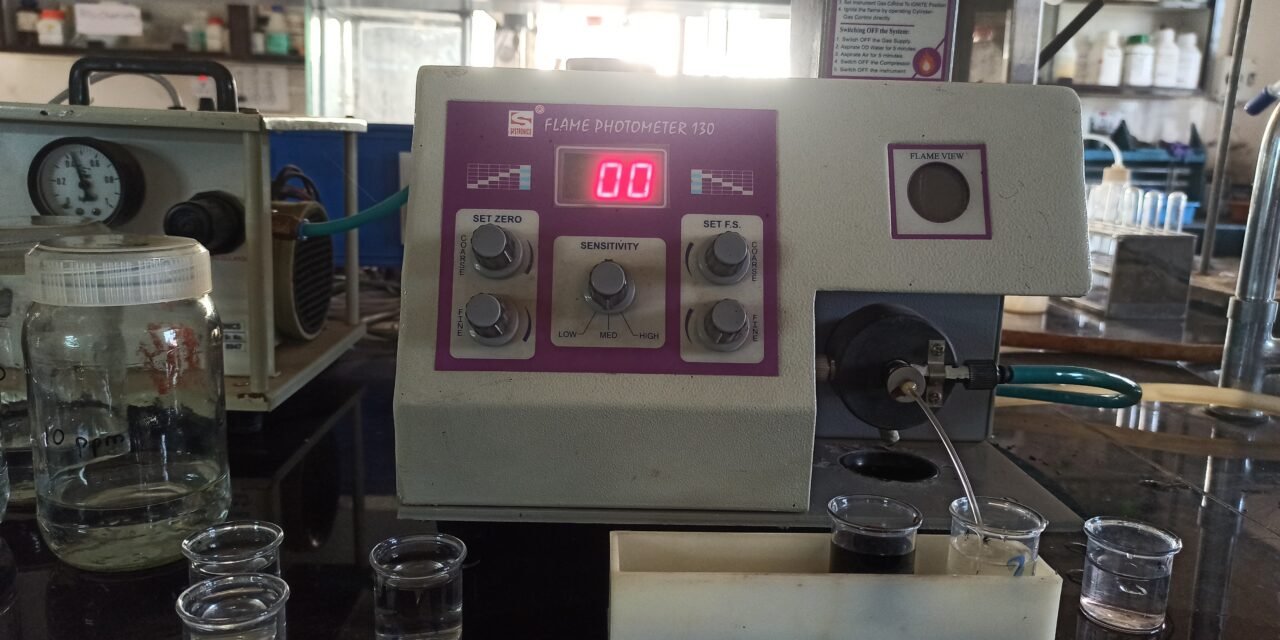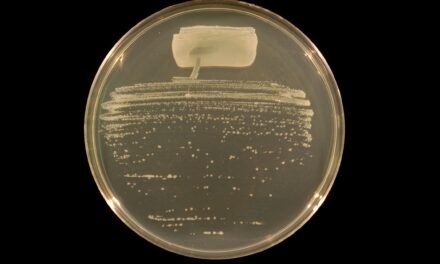Task:
To standardize the Flame Photometer and determine the Potassium content of the Given Sample
Principle of Flame Photometer:
The principle of flame photometers is based on the measurement of the emitted light intensity when metal is introduced into the flame. The wavelength of the color gives information about the element and the color of the flame gives information about the amount of the element present in the sample.

Preparation Standard Solutions for Standardizing the Flame Photometer: (19, 20 Feb 2022)
A) Ammonium acetate solution:
- Dissolve 77g of ammonium acetate in 900ml D.W.
- Adjust pH to 7.0 by adding 3N Sodium hydroxide solution
- Makeup volume up to 1 Liter
B) Standard Potassium Chloride Solution (1000 ppm):
- Dissolve 1.908 g Potassium Chloride in 1 liter D.W. to get a 1000 ppm solution of Potassium Chloride.
- From the above solution pipette out 1ml, 3ml, 5ml, and 10ml separately into different flasks and makeup volume to 100ml with D.W. We will get 10 ppm, 30ppm, 50ppm, and 100ppm standard solutions of Potassium Chloride.
Standardizing Flame Photometer: (20 Feb 2022)
- Ensure that the Air-Tube, Gas-Tube, and Drain-Tube are properly connected.
- Switch on the Compressor. Ensure that the output pressure is close to 0.45 Kg/cm2 and is stable.
- Dip the Atomizer capillary tube (plastic) in distilled water. Ensure the regular droplets fall in Drain-Cup and drain out.
- Open the FUEL GAS FINE ADJ Valve by approximately half a turn.
- Switch on the fuel supply from the fuel source/LPG cylinder and IMMEDIATELY IGNITE THE PLAME through the IGNITION Window.
- Watch the flame through the FLAME VIEW Window. Do fine adjustment of fuel flow with the help of the GAS control. Valve to get a stable flame having well-defined cones.
Once the burner unit is ignited and set, follow the steps described below:
- Turn on the Mains POWER switch. The digital display should turn on.
- Turn the SET FS, COURSE, SET FS, FINE, SET ZERO COARSE, and SET ZERO FINE controls in a maximum clockwise position.
- Set SENSITIVITY at HIGH.
- Select the filter Potassium (K).
- Feed distilled water to the atomizer, and wait for at least 30 seconds.
- Turn SET ZERO COARSE slowly in an anticlockwise direction till the readout of the digital display approaches zero.
- Adjust SET ZERO FINE to achieve a precise zero setting.
- Now feed the Standard solution of 100 ppm to the atomizer and wait for 30 sec.
- Turn SET FS, and COURSE in an anticlockwise direction till 100 is reached. SET FS FINE may be adjusted for precise settings.
- Feed other standard solutions of 10, 30, and 50 ppm solutions one by one, wait for 30 sec each time, and cross-check the reading weather showing correctly.
- Then feed the test sample solution (diluted) to the atomizer to get the relative concentration, wait for 30 sec, and then take the reading.
Dilution of test sample:
As the given test sample was concentrated, it needed to be diluted. Therefore, 1ml of the test sample was taken in a volumetric flask and makeup up to 100 ml with 20 ml of Ammonium acetate solution and remaining distilled water. Again 1 ml from of diluted sample was taken and again further diluted by adding more 20ml distilled water.


Results recorded (21 Feb 2021):
| Solution: | Reading: |
| Distilled Water | 0 |
| 10 ppm | 07 |
| 30 ppm | 30 |
| 50 ppm | 53 |
| 100 ppm | 100 |
| Test sample solution | 49 |
Calculations:
Dilution of Test Sample: 49 x 100 x 20 = 98,000
49 – Reading on the flame photometer
100- times of dilution
20- times of dilution
Therefore, the given test sample has 98,000 ppm potassium.
Testing for Potassium of Sample 2 brought from ASK using Flame Photometer (19/05/2022):
- Prepared a Standard solution of Ammonium acetate and Potassium chloride as even above.
- Calibrated Flame Photometer using standard solutions as directed above.
- Readings were recorded and plotted graph and the value of the unknown sample was exploited on the graph to find out the potassium content of the given sample.
Readings recorded:
| Solution | Reading |
| Diltilled Water | 0 |
| 10 ppm | 5 |
| 30 ppm | 35 |
| 50 ppm | 58 |
| 80 ppm | 77 |
| 100 ppm | 104 |
| Unknown sample | 175 |
Values Plotted on Graph:

Calculations:
The value of Unknown sample was = 161.05 ppm (when extrapolated on Graph)
But, sample was diluted 50 times before testing.
Therefore, the Potassium content of Unknown sample = 161.05 x 50
= 8,052.5 ppm





